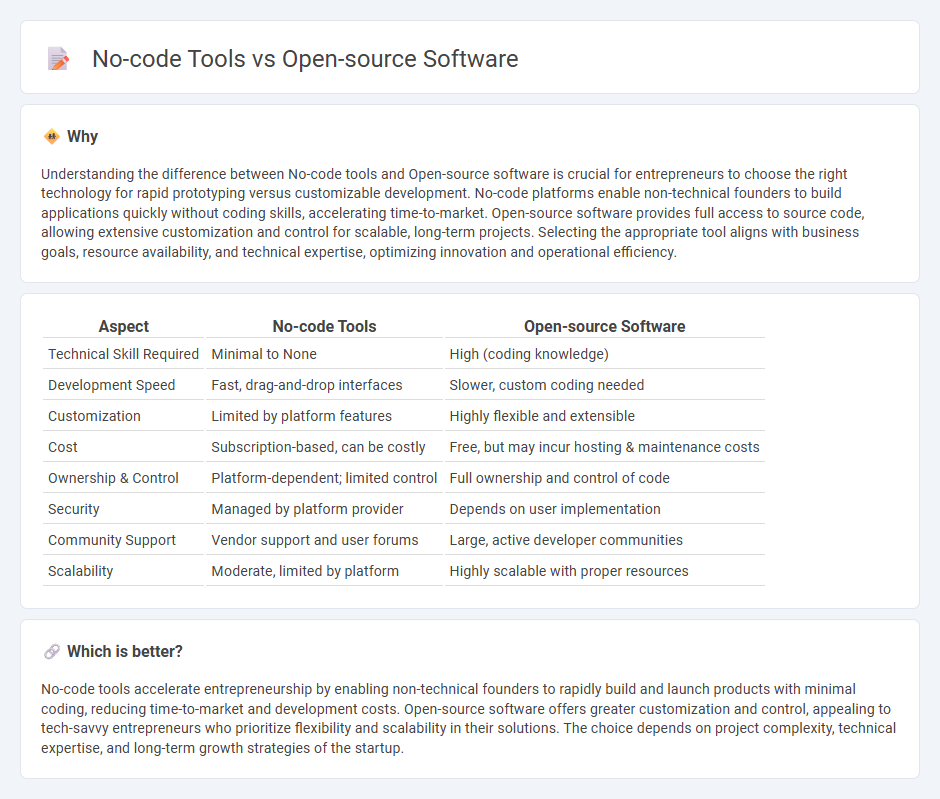
Entrepreneurs increasingly choose no-code tools for rapid application development and streamlined workflows without requiring extensive programming knowledge. Open-source software offers customization, control, and community-driven innovation, appealing to startups seeking flexibility and cost-efficiency. Explore the advantages and use cases of no-code tools versus open-source software to find the best fit for your entrepreneurial venture.
Why it is important
Understanding the difference between No-code tools and Open-source software is crucial for entrepreneurs to choose the right technology for rapid prototyping versus customizable development. No-code platforms enable non-technical founders to build applications quickly without coding skills, accelerating time-to-market. Open-source software provides full access to source code, allowing extensive customization and control for scalable, long-term projects. Selecting the appropriate tool aligns with business goals, resource availability, and technical expertise, optimizing innovation and operational efficiency.
Comparison Table
| Aspect | No-code Tools | Open-source Software |
|---|---|---|
| Technical Skill Required | Minimal to None | High (coding knowledge) |
| Development Speed | Fast, drag-and-drop interfaces | Slower, custom coding needed |
| Customization | Limited by platform features | Highly flexible and extensible |
| Cost | Subscription-based, can be costly | Free, but may incur hosting & maintenance costs |
| Ownership & Control | Platform-dependent; limited control | Full ownership and control of code |
| Security | Managed by platform provider | Depends on user implementation |
| Community Support | Vendor support and user forums | Large, active developer communities |
| Scalability | Moderate, limited by platform | Highly scalable with proper resources |
Which is better?
No-code tools accelerate entrepreneurship by enabling non-technical founders to rapidly build and launch products with minimal coding, reducing time-to-market and development costs. Open-source software offers greater customization and control, appealing to tech-savvy entrepreneurs who prioritize flexibility and scalability in their solutions. The choice depends on project complexity, technical expertise, and long-term growth strategies of the startup.
Connection
No-code tools and open-source software both empower entrepreneurs by reducing technical barriers and accelerating product development. No-code platforms enable non-technical founders to create applications quickly through visual interfaces, while open-source software provides customizable, cost-effective solutions that can be adapted to specific business needs. Together, they foster innovation and scalability, driving efficient startup growth with limited resources.
Key Terms
Accessibility
Open-source software provides extensive customization and flexibility, allowing users with coding skills to tailor solutions for diverse accessibility needs. No-code tools, designed for non-technical users, offer intuitive interfaces and quick deployment but may have limited accessibility options compared to open-source alternatives. Explore the strengths and limitations of both to determine the best fit for enhancing accessibility in your projects.
Customizability
Open-source software offers unparalleled customizability by allowing developers to modify source code, integrate unique features, and tailor applications to specific needs, making it ideal for complex, scalable projects. No-code tools provide limited customization through pre-built templates and drag-and-drop interfaces, which suit rapid development for users without programming skills but constrain advanced modifications. Explore more about how customizability impacts your software choice between open-source and no-code platforms.
Scalability
Open-source software offers unparalleled scalability by allowing developers to customize and optimize code to match growing business needs, supporting extensive integrations and complex workflows. No-code tools provide rapid deployment and ease of use but may face limitations in handling large-scale, highly customized applications. Explore the strengths and constraints of both to determine which solution best aligns with your scalability requirements.
Source and External Links
What Is Open-Source Software? (With Examples) | Indeed.com - Open-source software is computer software that allows anyone to use, study, change, and distribute it for any purpose, with well-known examples including Linux, Apache, VLC, Android, LibreOffice, Firefox, and WordPress.
What Is Open Source Software and How Does It Work? | Black Duck - Open source software (OSS) is software distributed with its source code, enabling modification and distribution by users, originated from an ideological movement started by Richard Stallman in 1983 and promoted by the Open Source Initiative founded in 1998.
What Is Open Source Software? - IBM - Open source software (OSS) is developed through open collaboration, allowing anyone to use, examine, alter, and redistribute the code, typically free of charge, and is fundamental in modern software development and enterprise DevOps workflows.
 dowidth.com
dowidth.com